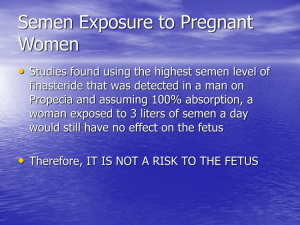Finasteride in sperm and the fetus
Dr Stewart McCallum (United States) quoted 2 studies by Merck in which the levels of finasteride were measured in the semen of men taking 5 mg of the finastride:
- Regarding the use of finasteride in men whose partners may be pregnant: It is a standard requirement for the FDA to ask for dedicated studies to look at drug concentrations found in semen. Merck performed 2 such studies, and the following is taken from the prescribing information. In 2 studies of healthy subjects (n = 69) receiving PROSCAR 5 mg/d for 6–24 weeks, finasteride concentrations in semen ranged from undetectable (<0.1 ng/mL) to 10.54 ng/mL. In an earlier study using a less sensitive assay, finasteride concentrations in the semen of 16 subjects receiving PROSCAR 5 mg/d ranged from undetectable (<1.0 ng/mL) to 21 ng/mL. Thus, based on a 5?mL ejaculate volume, the amount of finasteride in semen was estimated to be 50? to 100?fold less than the dose of finasteride (5 =?g) that had no effect on circulating DHT levels in men (see also PRECAUTIONS, Pregnancy). So the quantities of drug in the semen are 50? to 100?fold less than doses in serum which have been shown to have no effect on circulating DHT, and this is assuming that 100% of the of the finasteride present in the semen is absorbed by the female partner (which has not been confirmed). So the next question one would need to address is whether 50? to 100?fold coverage below doses that had no effect on circulation DHT is adequate. This is the risk benefit question that you need to address with your patient.
Although the above comments reference 2 studies using a 5?mg dose, Merck () also measured semen levels of finasteride in patients taking a 1?mg dose. The men were treated with 1 mg for 6 weeks. The highest level measured was 1.52 ng/mL, and the mean level was 0.26 ng/mL. Using the highest measured level (1.52 ng/mL), women exposed to a 5?mL ejaculate per day would be exposed to 7.6 ng/d (assuming 100% vaginal absorption). Merck () found this level to be 750 times lower than the “no effect” level for developmental abnormalities in rhesus monkeys.
In summary, a 1?mg dose of finasteride does not appear to adversely affect spermatogenesis. In addition, the level present in the ejaculate of patients taking 1 mg appears to be negligible. Thus, there does not appear to be any need to stop 1 mg of finasteride in those patients trying to conceive or in those whose partners are pregnant.
In 2001, Merck used the slide below to discuss the risks of the fetus to a man who fathers a child while on finasteride
from BaldingBlog - Hair Loss Info https://ift.tt/rCLBzqI


